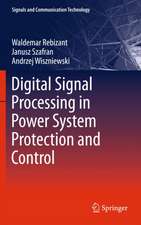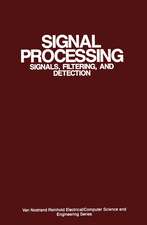Theory and Applications of Spherical Microphone Array Processing: Springer Topics in Signal Processing, cartea 9
Autor Daniel P. Jarrett, Emanuël A.P. Habets, Patrick A. Nayloren Limba Engleză Hardback – 2 sep 2016
The authors aim to advance the field of spherical array processing by helping those new to the field to study it efficiently and from a single source, as well as by offering a way for more experienced researchers and engineers to consolidate their understanding, adding either or both of breadth and depth. The level of the presentation corresponds to graduate studies at MSc and PhD level.
This book begins with a presentation of some of the essential mathematical and physical theory relevant to spherical microphone arrays, and of an acoustic impulse response simulation method, which can be used to comprehensively evaluate spherical array processing algorithms in reverberant environments.
The chapter on acoustic parameter estimation describes the way in which useful descriptions of acoustic scenes can be parameterized, and the signal processing algorithms that can be used to estimate the parameter values using spherical microphone arrays. Subsequent chapters exploit these parameters including in particular measures of direction-of-arrival and of diffuseness of a sound field.
The array processing algorithms are then classified into two main classes, each described in a separate chapter. These are signal-dependent and signal-independent beamforming algorithms. Although signal-dependent beamforming algorithms are in theory able to provide better performance compared to the signal-independent algorithms, they are currently rarely used in practice. The main reason for this is that the statistical information required by these algorithms is difficult to estimate. In a subsequent chapter it is shown how the estimated acoustic parameters can be used in the design of signal-dependent beamforming algorithms. This final step closes, at least in part, the gap between theory and practice.
| Toate formatele și edițiile | Preț | Express |
|---|---|---|
| Paperback (1) | 776.72 lei 6-8 săpt. | |
| Springer International Publishing – 14 iun 2018 | 776.72 lei 6-8 săpt. | |
| Hardback (1) | 782.72 lei 6-8 săpt. | |
| Springer International Publishing – 2 sep 2016 | 782.72 lei 6-8 săpt. |
Din seria Springer Topics in Signal Processing
- 18%
 Preț: 953.65 lei
Preț: 953.65 lei -
 Preț: 455.65 lei
Preț: 455.65 lei - 18%
 Preț: 1113.09 lei
Preț: 1113.09 lei - 15%
 Preț: 640.88 lei
Preț: 640.88 lei - 15%
 Preț: 643.48 lei
Preț: 643.48 lei - 15%
 Preț: 640.71 lei
Preț: 640.71 lei - 15%
 Preț: 704.04 lei
Preț: 704.04 lei - 15%
 Preț: 632.33 lei
Preț: 632.33 lei - 18%
 Preț: 781.45 lei
Preț: 781.45 lei - 18%
 Preț: 940.39 lei
Preț: 940.39 lei - 18%
 Preț: 728.28 lei
Preț: 728.28 lei -
 Preț: 424.61 lei
Preț: 424.61 lei - 15%
 Preț: 647.59 lei
Preț: 647.59 lei - 15%
 Preț: 605.39 lei
Preț: 605.39 lei - 18%
 Preț: 893.40 lei
Preț: 893.40 lei - 18%
 Preț: 947.35 lei
Preț: 947.35 lei - 15%
 Preț: 636.80 lei
Preț: 636.80 lei - 18%
 Preț: 776.88 lei
Preț: 776.88 lei - 18%
 Preț: 889.75 lei
Preț: 889.75 lei - 15%
 Preț: 641.03 lei
Preț: 641.03 lei
Preț: 782.72 lei
Preț vechi: 954.54 lei
-18% Nou
Puncte Express: 1174
Preț estimativ în valută:
149.78€ • 160.16$ • 124.88£
149.78€ • 160.16$ • 124.88£
Carte tipărită la comandă
Livrare economică 18 aprilie-02 mai
Preluare comenzi: 021 569.72.76
Specificații
ISBN-13: 9783319422091
ISBN-10: 331942209X
Pagini: 150
Ilustrații: XVI, 187 p. 45 illus., 42 illus. in color.
Dimensiuni: 155 x 235 x 13 mm
Greutate: 0.46 kg
Ediția:1st ed. 2017
Editura: Springer International Publishing
Colecția Springer
Seria Springer Topics in Signal Processing
Locul publicării:Cham, Switzerland
ISBN-10: 331942209X
Pagini: 150
Ilustrații: XVI, 187 p. 45 illus., 42 illus. in color.
Dimensiuni: 155 x 235 x 13 mm
Greutate: 0.46 kg
Ediția:1st ed. 2017
Editura: Springer International Publishing
Colecția Springer
Seria Springer Topics in Signal Processing
Locul publicării:Cham, Switzerland
Cuprins
Introduction.- Theoretical Preliminaries of Acoustics.- Spatial Sampling and Signal Transformation.- Spherical Array Acoustic Impulse Response Simulation.- Acoustic Parameter Estimation.- Signal-Independent Array Processing.
Textul de pe ultima copertă
This book presents the signal processing algorithms that have been developed to process the signals acquired by a spherical microphone array. Spherical microphone arrays can be used to capture the sound field in three dimensions and have received significant interest from researchers and audio engineers. Algorithms for spherical array processing are different to corresponding algorithms already known in the literature of linear and planar arrays because the spherical geometry can be exploited to great beneficial effect.
The authors aim to advance the field of spherical array processing by helping those new to the field to study it efficiently and from a single source, as well as by offering a way for more experienced researchers and engineers to consolidate their understanding, adding either or both of breadth and depth. The level of the presentation corresponds to graduate studies at MSc and PhD level.
This book begins with a presentation of some of the essential mathematical and physical theory relevant to spherical microphone arrays, and of an acoustic impulse response simulation method, which can be used to comprehensively evaluate spherical array processing algorithms in reverberant environments.
The chapter on acoustic parameter estimation describes the way in which useful descriptions of acoustic scenes can be parameterized, and the signal processing algorithms that can be used to estimate the parameter values using spherical microphone arrays. Subsequent chapters exploit these parameters including in particular measures of direction-of-arrival and of diffuseness of a sound field.
The array processing algorithms are then classified into two main classes, each described in a separate chapter. These are signal-dependent and signal-independent beamforming algorithms. Although signal-dependent beamforming algorithms are in theory able to provide better performance compared to the signal-independent algorithms, they are currently rarely used in practice. The main reason for this is that the statistical information required by these algorithms is difficult to estimate. In a subsequent chapter it is shown how the estimated acoustic parameters can be used in the design of signal-dependent beamforming algorithms. This final step closes, at least in part, the gap between theory and practice.
The authors aim to advance the field of spherical array processing by helping those new to the field to study it efficiently and from a single source, as well as by offering a way for more experienced researchers and engineers to consolidate their understanding, adding either or both of breadth and depth. The level of the presentation corresponds to graduate studies at MSc and PhD level.
This book begins with a presentation of some of the essential mathematical and physical theory relevant to spherical microphone arrays, and of an acoustic impulse response simulation method, which can be used to comprehensively evaluate spherical array processing algorithms in reverberant environments.
The chapter on acoustic parameter estimation describes the way in which useful descriptions of acoustic scenes can be parameterized, and the signal processing algorithms that can be used to estimate the parameter values using spherical microphone arrays. Subsequent chapters exploit these parameters including in particular measures of direction-of-arrival and of diffuseness of a sound field.
The array processing algorithms are then classified into two main classes, each described in a separate chapter. These are signal-dependent and signal-independent beamforming algorithms. Although signal-dependent beamforming algorithms are in theory able to provide better performance compared to the signal-independent algorithms, they are currently rarely used in practice. The main reason for this is that the statistical information required by these algorithms is difficult to estimate. In a subsequent chapter it is shown how the estimated acoustic parameters can be used in the design of signal-dependent beamforming algorithms. This final step closes, at least in part, the gap between theory and practice.
Caracteristici
Offers a single source explanation of spherical microphone array signal processing Presents a unified presentation of a wide body of material and the complete state of the art Includes the essential mathematical and physical theory Includes supplementary material: sn.pub/extras


























